Liverpool are in the middle of a frustrating run of form, and that can partially be attributed to the challenges they are facing on the pitch with a low block.
The Reds’ success seems to go in cycles, with periods that suggest sides have sussed them out, stifling their suffocating overload with a cynical, defensive approach.
More often than not, Jurgen Klopp‘s side find their mojo again in due course, and the wins begin to roll in, which is hopefully to be the case following a run of four Premier League games without a win.
But after experiencing difficulty against the low block of West Brom, Newcastle, Southampton and Man United – in which they enjoyed an average of 71 percent possession but only scored once – they come up against three similar tests in the next fortnight.
First comes Burnley, at Anfield, with Sean Dyche’s side 18th in the league when it comes to possession (43.3%), while also averaging the most long balls per game (77).
Then, after the FA Cup clash with United, is a visit to Tottenham, who under Jose Mourinho are 13th in terms of possession (49.2%) and have scored the joint-third most counter-attacking goals (three, level with Liverpool).
January ends with an away trip to West Ham, who are just ahead of Burnley in terms of possession (43.4%) and bear the recognisable hallmarks of a David Moyes side.
Liverpool desperately need a response to revive their title hopes, so how could Klopp switch things up to pick apart a tight-knit defence?
Overload the flanks

It may seem more of the same, but the obvious solution to breaking a low block, which crowds bodies in and around the penalty area, is an emphasis on attacks down the flanks.
Liverpool are blessed with two of the finest full-backs in world football in Andy Robertson and Trent Alexander-Arnold, but both have struggled for form in recent weeks.
Robertson appears to be suffering the effects of fatigue, as the Reds’ most-used player this season, while Alexander-Arnold is yet to fully hit his stride following a pre-season ravaged by COVID-19 and a calf injury in November.
Perhaps it is simply a case of awaiting their improvement, but Klopp does have other options at full-back, namely Neco Williams and the returning Kostas Tsimikas.
With Tsimikas back in training and Williams having impressed against Aston Villa in the FA Cup, rotation – maybe as early as the arrival of Burnley on Thursday night – and rest for the current incumbents could spark a reinvigorated approach.
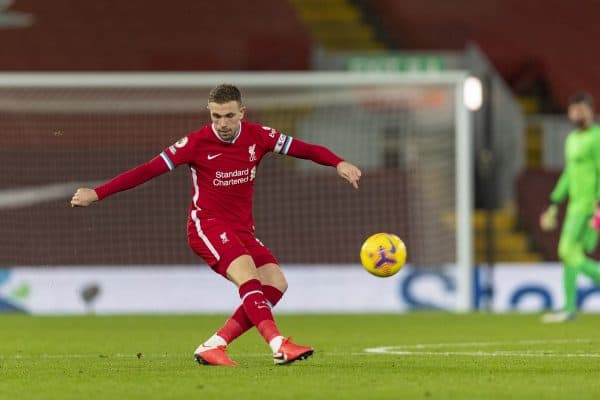
Jordan Henderson‘s deployment as a left-sided centre-back against United saw the return of the raking long passes out wide that have become a staple of Virgil van Dijk‘s game, and this could be required of Fabinho if Joel Matip is back to partner him.
Similarly, the presence of Thiago in midfield can allow Liverpool to shift the dynamic quickly to pounce on any lapses of concentration from the opposition – one well-timed pass could see one of the full-backs through for a decisive cross.
More danger from long range
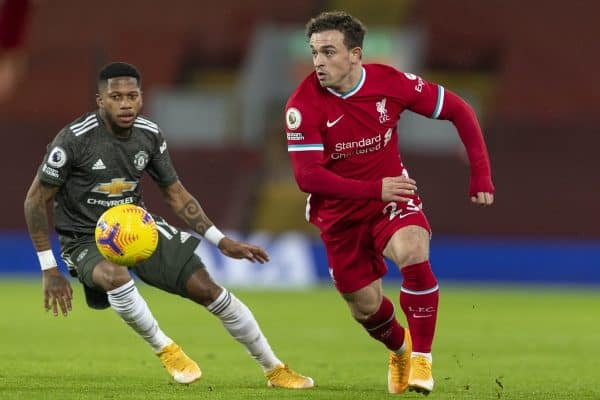
Following Philippe Coutinho‘s exit to Barcelona in 2018, it was routinely bemoaned that Liverpool no longer have a player with the skillset to unlock a packed defence or trouble goalkeepers from range.
But the return of Xherdan Shaqiri to the starting lineup – for the first time in the Premier League in 13 months – against United highlighted a player of that ilk finally gaining rhythm.
Shaqiri was one of the brighter points of the Reds’ latest draw, and though he visibly tired towards the end of his 76-minute appearance, his willingness to open up and attempt to test David de Gea from range was encouraging.
If Liverpool can’t work their way through a low block, the best route may be more direct – and with a player with Shaqiri’s ability from range in the side, that could be a real threat.
Whether the Swiss is best deployed in a midfield three is questionable, however, which could open up the debate over a change of system.
Salah up top in a 4-2-3-1
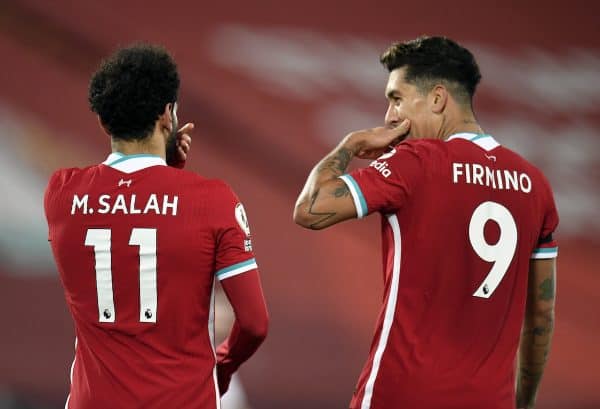
It has been noted that, in the absence of Van Dijk as the Reds’ secret weapon in possession, Klopp’s 4-3-3 has become flatter, more predictable and more easily managed.
This is magnified by the poor form of Sadio Mane, Mohamed Salah and, in particular, Roberto Firmino, who have managed just one league goal between them since the 7-0 thrashing of Crystal Palace.
Firmino’s malaise is the biggest concern, and with Takumi Minamino strangely unused in the league since scoring in that comprehensive win at Palace, it could be that the Brazilian requires a break from the side as Liverpool’s No. 18 comes in.
But perhaps Firmino would simply benefit from a change of position, one which would alleviate the pressure of finishing chances as was clearly the case against United.
When shifting away from his 4-3-3 in the past, Klopp has turned to a 4-2-3-1 setup, most often with Salah leading the line and Firmino dropping into the No. 10 role.

This sacrifices the stability of a three-man midfield, but against sides likely to sit back, defend and look to threaten on the counter, this is much less of an issue.
A 4-2-3-1 could restore Firmino to the between-the-lines duty that sees him thrive, while Salah’s pace and the instinctive movement of Mane from wide to inside would ask more questions of a low-block defence.
Similarly, a 4-2-3-1 could see Shaqiri given more license in the final third – and in the absence of Diogo Jota, he appears the best candidate to step into a four-man attack.
During this frustrating run, and against United in particular, there have still been signs of the Liverpool that has been so successful under Klopp, but an element of luck has been lacking.
The manager is adamant that if the Reds keep creating, their scoring touch will return, and it could just take a few minor tweaks to ensure this is the case in the games ahead.
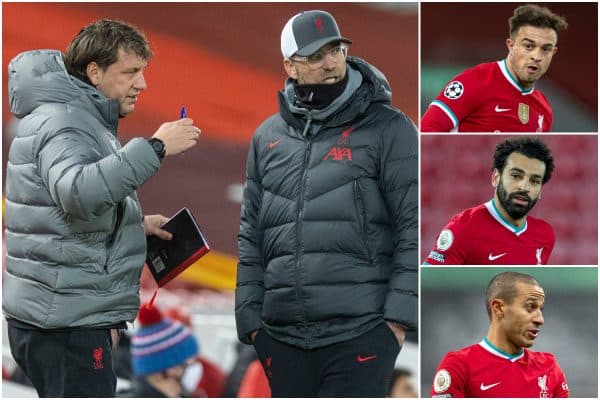







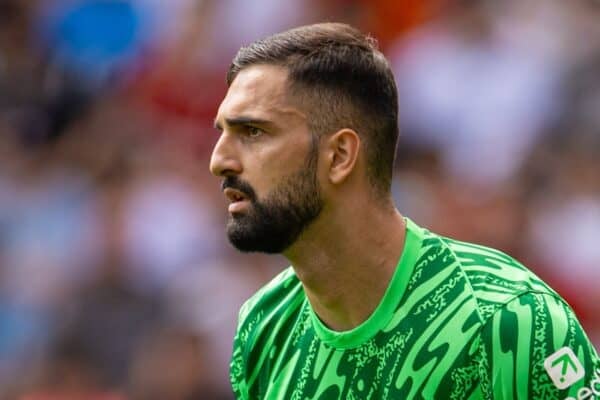




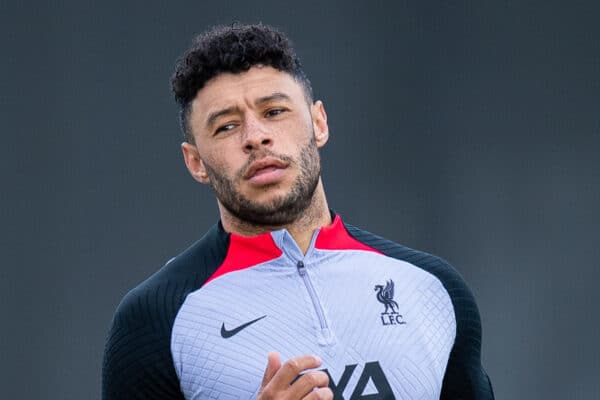


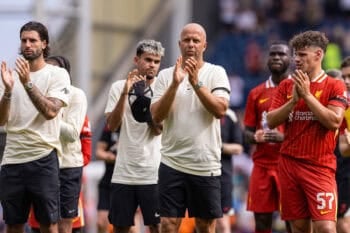


Fan Comments